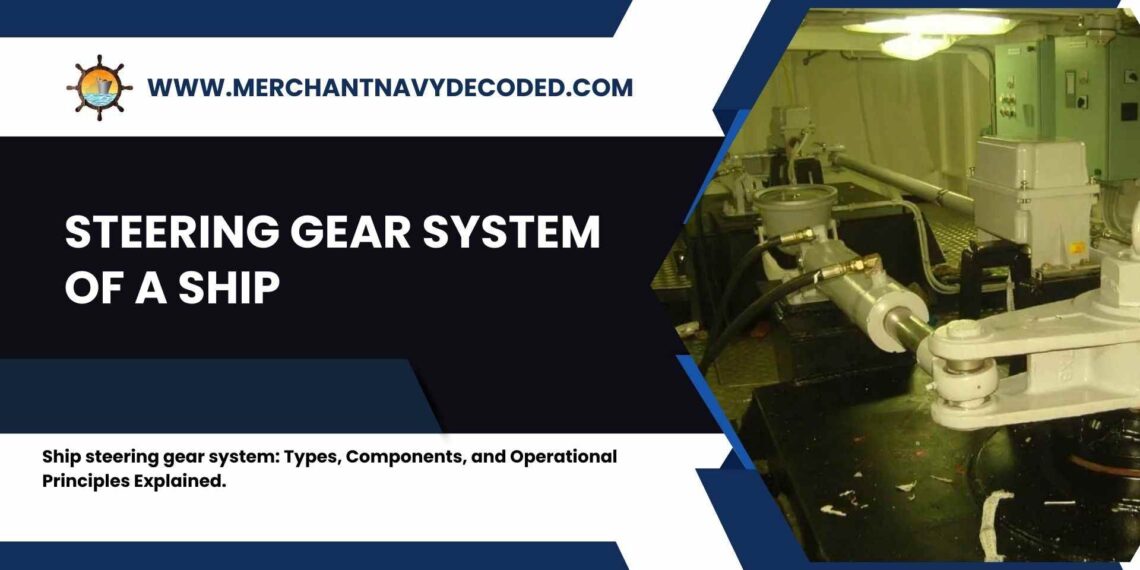Steering Gear System On Ship
1:- Overview
Steering gear system is essential equipment on ships, and it is responsible for controlling the rudder of ship to change the vessel’s direction during navigation.
The steering gear system on the ship connects the helm (the steering wheel) on the bridge to the rudder, allowing the ship to steer.
The steering gear is necessary for avoiding collisions, navigating through tight spaces, and providing stability in difficult circumstances. It works in coordination with other vital safety and control equipment.
2:- What is a Steering Gear System?

The steering gear system on a ship is an essential system that is responsible for changing the direction of the ship during navigation by controlling the rudder.
- It is a system that converts commands from the helm, which are usually managed by the autopilot system or the ship’s commander, into the physical movements that direct the vessel’s path.
- Modern ships use complex steering mechanisms, which might be hydraulic or electro-hydraulic, to ensure accuracy and reliability in diverse sea situations.
3:- Parts of Steering Gear System

The steering gear system consists of three major parts: the telemotor, which transmits orders from the helm to the steering gear; the control unit, which manages the rudder’s movement; and the power unit, which provides the mechanical force necessary to turn the rudder.
3.1:- Telemotor
The telemotor in the steering gear system is the device responsible for transmitting steering commands from the ship’s bridge to the steering gear located in the steering gear room. The telemotor is usually located on the navigation bridge in the form of a steering wheel or helm, where the helmsman initiates the command and sends hydraulic or electrical signals through the system to the receiver. Then the receiver translates this signal into mechanical movement, adjusting the steering gear and, turning the rudder.
3.2:- Control Unit
The control unit in the steering gear system acts as the intermediary between the telemotor and the power unit. It receives the steering signal from the telemotor and processes it, ensuring the rudder moves to the correct position. This is done through a feedback system, typically referred to as hunting gear, which monitors the rudder’s movement and sends feedback to stop or adjust the rudder angle to the desired position.
3.3:- Power Unit
The power unit in the steering gear system provides the physical force necessary to turn the rudder. The two types of power units that generate the force needed to operate a ship’s massive rudder are hydraulic power units and electro-hydraulic units. The power unit operates by converting mechanical or electrical energy into hydraulic power, which is then used to move the steering gear. It controls the flow of hydraulic fluid into cylinders or pressurized chambers.
4:- Types of Steering Gear Systems
Different types of steering gear systems have been developed over time in response to the needs of evolving technology, varying ship sizes, and operational requirements.
Steering gear systems onboard ships range from advanced electro-hydraulic systems to conventional mechanical setups in terms of both design and functionality.
The main types of sterling gear systems are :
- Ram-type steering gear
- Rotary vane-type steering gear
- Electro-hydraulic steering gear
- Rotary steering gear
- Mechanical steering gear
5:- Ram Type Steering Gear of Ship

- The Ram Type of Steering Gear is used widely because of its strong and dependable ability to produce high torque—a necessary quality for maneuvering heavy rudders—this technology is frequently utilized in large ships.
- Ram Type Steering Gear functions according to hydraulic principles, using a pressurized fluid to precisely regulate the rudder’s movement.
- Ram Type Steering Gear system is particularly advantageous because of its ability to generate high torque, making it suitable for large vessels that require significant force to steer, especially in challenging sea conditions.
- The hydraulic operation ensures smooth, controlled rudder movements, which contributes to the vessel’s stability and maneuverability.
6:- Rotary Vane-Type Steering Gear of Ship

- The Rotary Vane-Type Steering Gear is a compact and efficient system used to control a ship’s rudder by converting hydraulic pressure into rotary motion.
- Unlike the ram-type system, which uses linear motion, the rotary vane system operates through rotational movement.
- The electronic controls allow for precise adjustments and the capability for automated steering, enhancing overall navigation.
- The hydraulic rotation provides a smooth and continuous movement, ensuring precise control of the rudder.
- Rotary Vane-Type Steering Gear is commonly used on medium-sized vessels, such as cargo ships and offshore vessels, where compactness and efficiency are priorities.
7:- Electro-Hydraulic Steering Gear System of Ship

- The Electro-Hydraulic Steering Gear is an advanced mechanism that combines electrical and hydraulic technologies to control a ship’s rudder, providing precise and reliable steering.
- Electro-Hydraulic Steering Gear is particularly beneficial and widely used in large commercial vessels, including container ships, cruise liners, and tankers, where effective steering and navigation are critical for safe operation.
- The Electro-Hydraulic Steering Gear system’s efficiency and advanced technology make it a popular choice in modern maritime engineering.
8:- Rotary Steering Gear of Ship
- The Rotary Steering Gear is a type of mechanical steering system that operates through the use of a rotary screw mechanism to control the rudder.
- The rotary screw system is mechanically simple and does not require complex hydraulics or electronics, making it easy to maintain.
- This system is typically found on smaller vessels or used as an auxiliary or backup system in larger ships.
- The rotary steering gear system’s key feature is the conversion of rotary motion from the screw into linear motion, which moves the rudder.
- The rotary steering gear system Its compact nature allows it to be fitted in small spaces, which makes it ideal for small boats or as auxiliary steering.
9:- Mechanical (Chain and Wire) Steering Gear of Ship

- The Mechanical Steering Gear is one of the oldest and simplest types of steering systems, primarily used in smaller vessels or as a backup system in larger ships.
- mechanical steering gear uses a series of chains, wires, and pulleys to control the rudder manually.
- The mechanical steering gear is very simple, it involves mechanical parts like pulleys, drums, chains, and wires.
- mechanical steering gear works entirely on manual input, providing direct control of the rudder with little or no reliance on power systems
- Due to its mechanical nature, this system requires minimal maintenance, aside from ensuring the wires and chains remain properly tensioned and lubricated. It is compact and it can be installed in smaller vessels with limited spaces.
10:- Auxiliary Steering Gear System on Ship

- An auxiliary steering gear system is a backup system or a secondary system installed on the ship to keep the ship under control if the main steering gear fails.
- The auxiliary steering gear remains on standby and is activated only when the main steering system fails, it is controlled from the same steering console.
- The auxiliary Steering Gear System offers backup and guarantees that, if the primary system experiences mechanical or electrical issues, the ship can maintain course or be brought to a safe port.
- Auxiliary Steering Gear System ensures that a ship can continue its voyage safely. It is built to function as a backup with smoothness and efficiency, ensuring that the crew can manage unexpected technical problems without losing control of the vessel.
- The power actuating system must be able to change the rudder in less than 28 seconds, from 35° on one side to 35° on the other, while the ship is at its deepest sea-going draft and moving forward at its maximum ahead service speed.
11:- Emergency Steering Gear System

This system is used for critical situations where both the main and auxiliary steering gear systems are non-functional or severely compromised.
Emergency steering gear system allows for minimal, yet essential, control of the ship’s rudder to ensure that the vessel can be navigated to safety, such as avoiding hazards or reaching port. It is often slower and requires more manual effort or basic mechanical / hydraulic force to control the rudder.
Emergency steering gear system can be controlled directly from the steering gear compartment, often located in the aft part of the ship, where the rudder is physically located. It is typically operated manually or through basic mechanical means.
Note:
According to SOLAS (Safety of Life at Sea) regulations, ships must be equipped with an emergency steering system that allows them to steer the ship effectively in the event of a main and auxiliary steering system failure.
12:- Conclusion

The steering gear system is equipment on a ship that helps in navigating the ship and exact control over a vessel’s course.
- The steering gear system consists of various components such as the telemotor, control unit, and power unit that work together to move the rudder.
- Different types of steering systems, from traditional mechanical to advanced electro-hydraulic, offer unique benefits for various ship sizes and operational needs.
- Auxiliary steering systems provide backup in case the main system fails, ensuring continued control of the vessel.
- Emergency steering systems offer minimal control during critical failures of both the main and auxiliary systems.
- SOLAS regulations require ships to have emergency systems to maintain safe navigation in the event of steering failures.
- Overall, reliable steering systems are crucial for the safety, maneuverability, and efficiency of maritime operations.
13:- Steering Gear system FAQ
The steering gear system controls a ship’s rudder, allowing it to change direction. It translates commands from the bridge into a mechanical movement to steer the vessel.
The main components of a Steering Gear System are: Rudder, Actuators, Power units, Control unit, Feedback mechanisms.
Hydraulic oil is pressurized by a pump and directed through valves to move the actuator, which turns the rudder. A hydraulic ram or rotary vane mechanism is used to convert fluid pressure into mechanical movement.
The rudder angle indicator shows the position of the rudder in degrees. It’s essential for the helmsman and engineers to know the exact position to steer the ship safely.
Disclaimer :- The opinions expressed in this article belong solely to the author and may not necessarily reflect those of Merchant Navy Decoded. We cannot guarantee the accuracy of the information provided and disclaim any responsibility for it. Data and visuals used are sourced from publicly available information and may not be authenticated by any regulatory body. Reviews and comments appearing on our blogs represent the opinions of individuals and do not necessarily reflect the views of Merchant Navy Decoded. We are not responsible for any loss or damage resulting from reliance on these reviews or comments.
Reproduction, copying, sharing, or use of the article or images in any form is strictly prohibited without prior permission from both the author and Merchant Navy Decoded.



